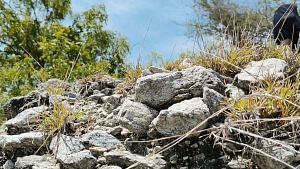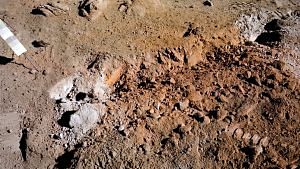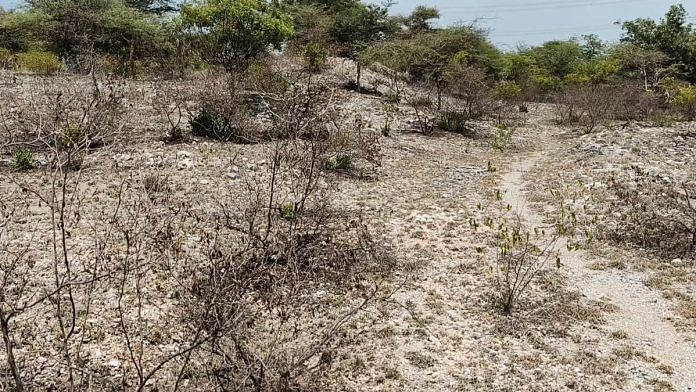Namakkal: There is something about the mud in Tamil Nadu’s Sithampoondi. It is expensive, rare and has played a key role in the success of ISRO’s mission to the moon.
The earth caves make a valley-like structure at the cross-junction of three villages –Sithampoondi, Kunnamalai, and Dhasampalayam – in the state’s Namakkal district. About two decades ago, the land here was mostly flat, and the gorge was filled with soil. Now, half of its soil, almost 50 tonnes, is in Bengaluru and utilised by ISRO.
Its similarity to lunar soil made it the perfect testing ground for Chandrayaan-III, Pragyan Rover, Vikram Lander, and other past missions. It’s a badge of honour for residents who are proud that their land is linked to India’s space progress and the recent success of Chandrayaan-III.
“Our name has been published and is being repeated across the country and the world,” says farmer P Nandakumar.
Over the last few weeks, reporters and camera crew, as well as school students and teachers, have been visiting Sithampoondi, and residents have been more than happy to play tour guides. But at the same time, there is an undercurrent of fear that they will lose their agricultural lands due to the soil’s speciality.

S Anbazhagan, professor and head of the geology department at Periyar University in Salem, was the first to establish the chemical and mineralogical similarities between Sithampoondi and moon soils. He reached this conclusion nearly two decades ago in 2004 when he was an associate professor with the Department of Earth Sciences at IIT-Bombay.
“It had similar mineralogy, chemistry, grain size and geotechnical properties like that of the soil on the moon,” he says.
Moreover, Anbazhagan found that Sittampoondi’s soil was similar to that on the Moon’s south pole.
It turned out to be a fortuitous—and cost-saving discovery. India’s soil scientists approached Anbazhagan after the Chandrayaan-I mission in 2008. They wanted suggestions on what soil they could use to test future missions. They needed large quantities of moon-like soil to conduct landing experiments.
Until then, ISRO purchased a few kilograms of such soil from NASA. But each kilo cost $150, and that was back in 2008-09, says Anbazhagan. Importing large quantities of soil would have increased project costs by another Rs 40-50 crore.
“ISRO scientists needed to study how the lander would sit on lunar soil, and how the rover could move without any friction and other aspects,” — Anbazhagan.
India needed its own source of ‘moondust’, and Sittampoondi had the solution. It’s been supplying soil to ISRO since 2012.
Also read:
Sithampoondi’s unique soil
Located 400 kilometres from Chennai, Sithampoondi and its surrounding areas are filled with lush sugarcane, paddy and tapioca fields. However, this greenery contrasts with the region’s dry and empty terrain. This soil, covered with white, grey, black, beige, red and brown pebbles, and mixed with graphite and black stones, is home to hardy trees and shrubs like jujube.
Anorthosite, one of the world’s oldest igneous rocks, is also found here. “It can tell the story about how the earth originated, different origin theory and the rock here is estimated to be 2500-2700 million years,” says Anbazhagan.
This unique soil was also in demand during World War II, says K Gunasekaran, former president of the Kunnamalai Panchayat.
“During World War II, the region was mined for making bullets for the war.”
It isn’t an old village tale. Anbazhagan, too, confirms that Sithampoondi and its neighbouring hamlets were thoroughly explored for minerals in the country’s pre-Independence era.
“During World War II, there was a need for aluminium to make bullets. Britishers mined out garnet mineral, an aluminium silicate from the region. From the garnet, aluminium was further extracted, and bullets were made,” says historian K Saravana Kumar.

The land still bears large cavities to the depth of 30-50 feet—a reminder of the rich mineral deposits it once had. In 2010, explorations resumed, but this time by the Geological Survey of India, which was looking for the presence of platinum group elements such as palladium, rhodium, ruthenium, osmium, and iridium.
Until 2018, holes were drilled up to 120 metres at regular 50-metre intervals to ascertain the continuity of deposits and their concentration. These digs were carried out in several parts of 23 villages, including Silthampoondi, Dhasampallayam, and Kunnamalai.
“At present, the extraction of platinum from here is not economically worthwhile, and hence, it has been put on hold,” says Anbazhagan.
According to Sakthivel Marapakounder, the panchayat president of Dashampallayam, there were fears that mining operations would begin in the region. And though unfounded, these claims have affected the sale of land, he says.
“In the last few years, people have stopped buying lands [within a] 10-kilometre radius —around 4,000 to 5,000 acres.”
Also read:
Villagers are scared & proud
ISRO’s next mission to the moon will likely be in collaboration with Japan Aerospace Exploration Agency (JAXA). The Lunar Polar Exploration Mission (LUPEX) is slated to launch in 2025. With India developing the lander and JAXA developing the rover, Namakkal’s soil, which is placed in the lunar terrain testing facility at ISRO’s headquarters in Bengaluru, will be put to maximum use.
Their connection with ISRO, the moon and Chandrayaan makes villagers proud, but they also worry that they will lose their land.
“Farmers fear that their livelihood will be affected and that their agricultural lands will be taken away eventually due to the soil’s speciality,” says Gunasekaran.
And rumours are spreading already.
“We don’t want our villages to become like Neyveli [a lignite mining hub] in Tamil Nadu. We don’t want our agricultural lands destroyed,” says Bhuvaneshwari Sakthivel, another villager.
Government officials have dismissed these fears as baseless. “As of now, there is no activity in the region with regard to extracting platinum,” one official reveals on condition of anonymity.
(Edited by Zoya Bhatti)



